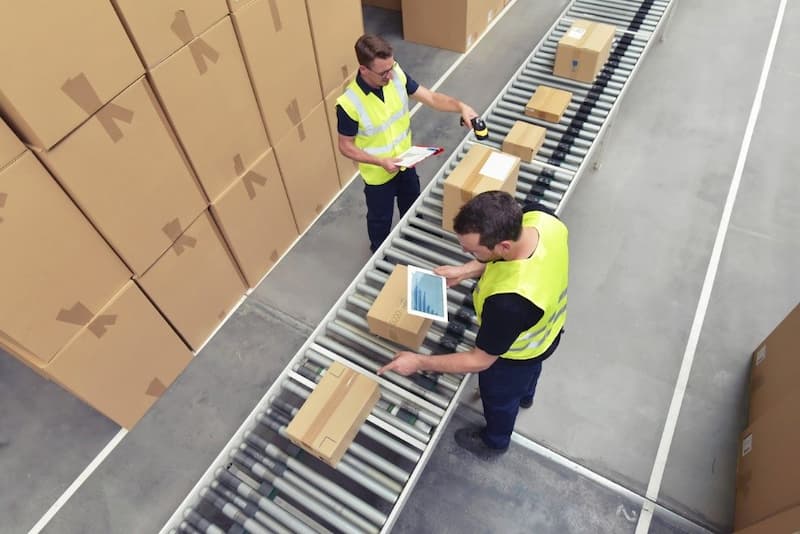
Effective warehouse management primarily relies on visibility, coordination, and strategic planning. To accomplish this, businesses and organisations must leverage technology solutions that enable them to share data, collaborate, and conduct warehouse operations effortlessly. Fortunately, recent advances in warehouse technology have simplified the job for e-Commerce retailers.
The latest warehouse technologies provide more automation and efficiency, from data exchange platforms to storage and retrieval tools. At GSM Barcoding, we understand the importance of optimising workflow in a warehouse. We will discuss various tools to help businesses improve all warehouse management systems.
Read our blog to learn how to digitalise your warehouse operations and enhance your business’s productivity.
What is Warehouse Technology?
Warehouse technologies are used to increase efficiency and productivity. These technological solutions help businesses with warehouse automation and management. Including:
- Order processing
- Inventory management
- Packing and fulfilment
- Internal product transportation
- Receiving and storage
Some programmes even allow you to completely automate specific operations, while others help you speed up and increase the accuracy of your processes.
Wireless Networking
Wireless networking is a technology that enables devices to communicate with each other without the need for physical cables. This technology is essential for warehouse operations, allowing real-time data exchange between devices, such as:
And with wireless networking, warehouse workers move freely around the warehouse while still having access to all the tools they need.

Android Industrial Devices
Android industrial devices are ruggedised mobile devices designed for use in harsh environments such as warehouses. These devices are equipped with features such as barcode scanners, RFID readers, and cameras, making them ideal for inventory management and order fulfilment.
The RIFD printers and scanners we supply provide a superior solution. These mobile warehouse inventory solutions deliver real-time counts and locations, from raw materials to manufactured commodities. Therefore, with these wireless Android devices, you will restock ahead of time, reduce shrinkage, and keep your supply chain in good shape.
Warehouse Management Systems (WMS)
A warehouse management system (WMS) is a software application designed to manage and optimise warehouse operations. A robust, digital warehouse management system is essential for any business with on-hand inventory; it can also help save money and gain new efficiencies in many different areas.
These benefits are:
- Improved operational efficiency
- Reduced waste and costs
- Real-time inventory visibility
- Improved labour management
- Better customer and supplier relationships

Barcode Labels and RFID Tags
Using electromagnetic waves, RFID, or radio-frequency identification technology, allows warehouses to keep track of their products in real-time. Warehouses often attach RFID tags to their items or shipments and track the actual movement of inventory throughout the warehousing process. Unlike barcodes, RFIDs do not require scanners to track inventory movement, allowing for greater automation.
Alternatively, the far more common barcode labels are designed to include detailed information about a package’s contents and its relationship with all the other items in your storage facility. They also calculate how many pieces are in stock, making inventory tracking easier in your computer database.
Furthermore, these printed shipping barcodes are used to trace items as they move through various stages of the shipping and fulfilment process. This gives you more visibility over your orders as they are dispatched from your warehouses and dropped off at various touchpoints until they arrive at their final destination.

Robotics
Robotics is a technology that is transforming warehouse operations. Various robotic designs are programmed to perform various tasks, including:
- Inventory management with portal gateways
- Order fulfilment with robotic arms or AS/RS
- Transportation with conveyor belts or AGVs
With robotics, businesses automate repetitive tasks, reduce labour costs, and improve efficiency.
Types of Warehouse Robots
Warehouse robotics reduces the time and resources required to obtain and transfer things throughout the warehouse floor, freeing human workers to focus on more complex activities such as packaging and shipping orders.
- Automated Guided Vehicles (AGVs) – Materials, supplies, and inventory are transported within warehouse facilities using automated guided vehicles. In operations, AGVs are used to replace manually powered forklifts.
- Automated Storage and Retrieval Systems (AS/RS) – AS/RS systems automate inventory management and store/retrieve goods on demand, allowing for faster order fulfilment and materials handling operations.
- Collaborative Robots – Collaborative robots are semi-autonomous mobile robots designed to help human workers perform diverse tasks in the warehouse environment.
- Articulated Robotic Arms – Articulated robotic arms are a type of pick-and-place robot. It is made of a multi-jointed limb used to manipulate products within distribution centres and warehouses.
- Goods-to-Person (G2P) – Goods-to-Person technology operates on the same idea as an AS/RS system. G2P technology leverages an automated storage system to deliver items to stationary pick stations where human operators fulfil orders.
GSM Barcoding: UK Leading Supplier of Warehouse Technologies
GSM Barcoding is the sole answer to finding the best solution for your warehouse efficiency, whether large or small. As barcoding systems experts, we help any size warehouse with its stock control, asset tracking, and mobility solutions.
If you would like more information on any of our services or products, contact us directly online, and a staff member will respond as soon as possible.


















